Winter in Yellowstone is more fun than I expected.
The weather can be challenging at times, no question. But in return the park is liberated from the stifling crowds of summer, and a blanket of snow makes it easier to spot wildlife.
I’m also realizing how lucky it is that the one park road open to regular vehicles in winter happens to run through Lamar Valley. “America’s Serengeti” some call it – definitely a reach, but not outrageous. Where else in the continental Unites States can you find a more amazing concentration of wildlife? Bears, wolves, elk, bison, moose, bighorn sheep, eagles – a drive through Lamar Valley feels like a safari.
I’d heard there were also river otters in Lamar Valley. Someone showed me the area where they supposedly have a den, but all throughout December I failed to find them. My luck finally changed a week into the new year when I spotted three otters running along an icy channel of the Lamar River. I raced to the riverbank, along with many other excited photographers, and spent almost two hours watching the otter family play, fish, and then settle down for a nap. Few animals are more fun to watch.
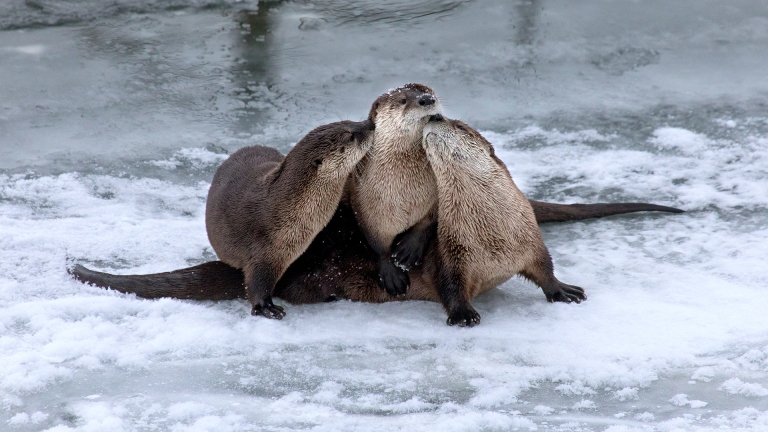
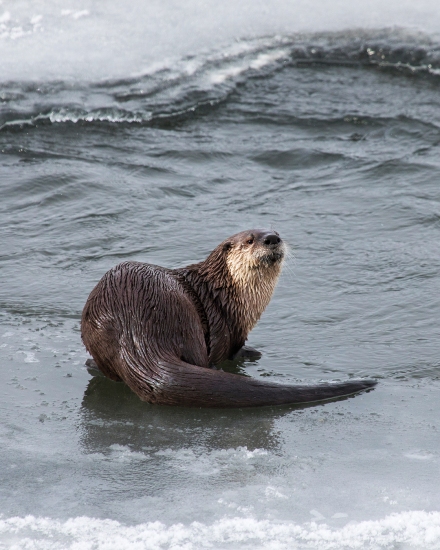
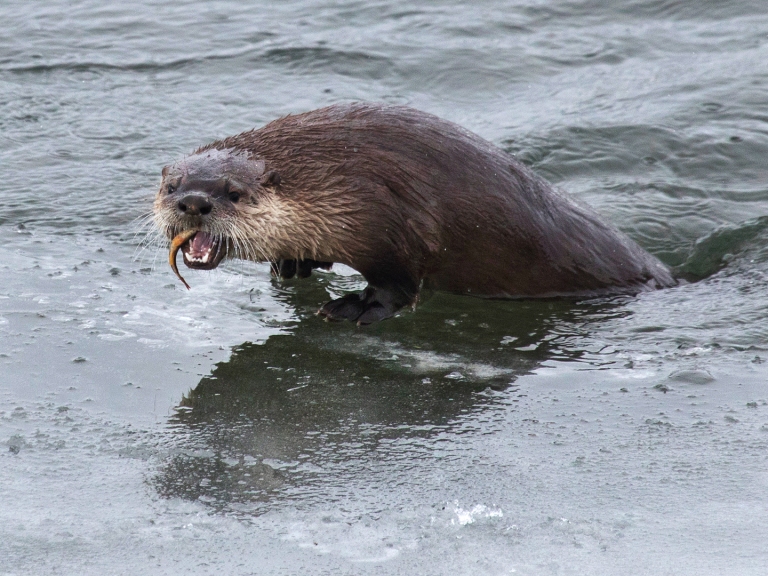

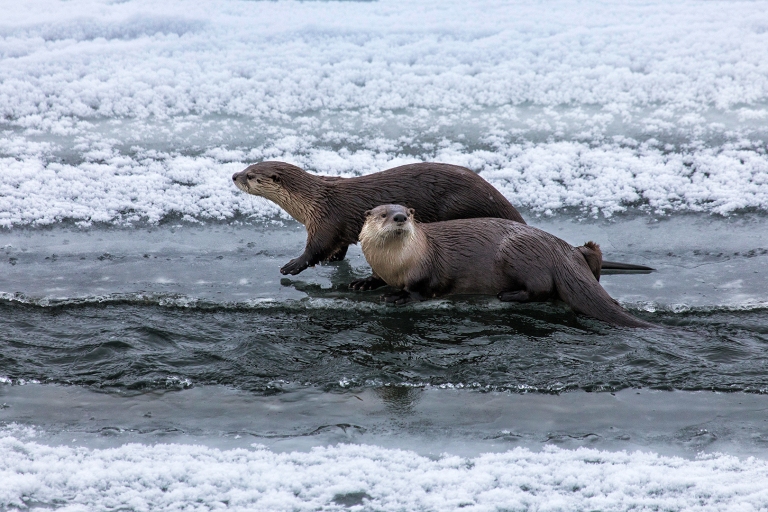
The otter encounter checked one of Yellowstone’s tougher-to-find animals off my wish list, and soon I checked off another. As snow fell one morning I stumbled across a bull moose grazing happily on a patch of willow shrubs, very near the road.
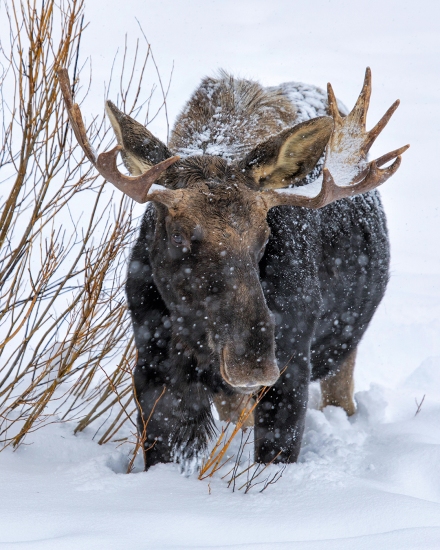


By mid-January moose were appearing so regularly that I sometimes just passed right by unless they happened to be very near.
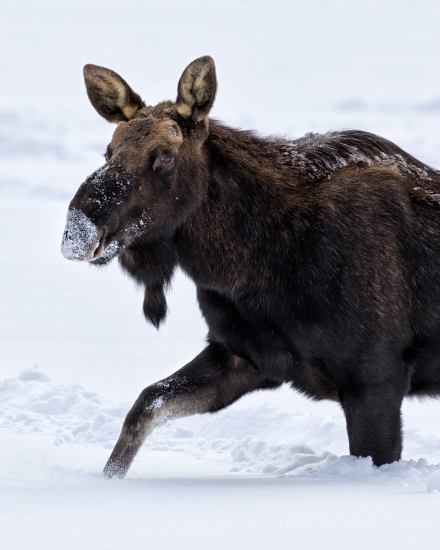

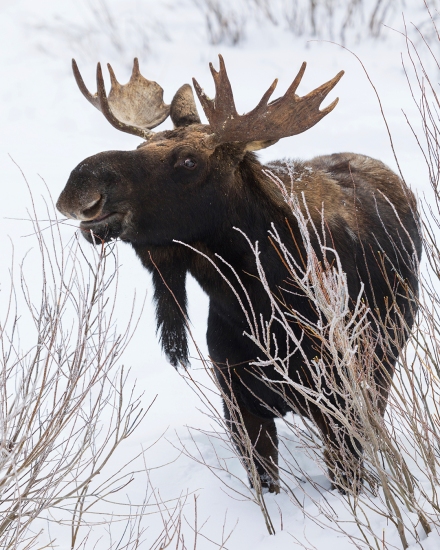

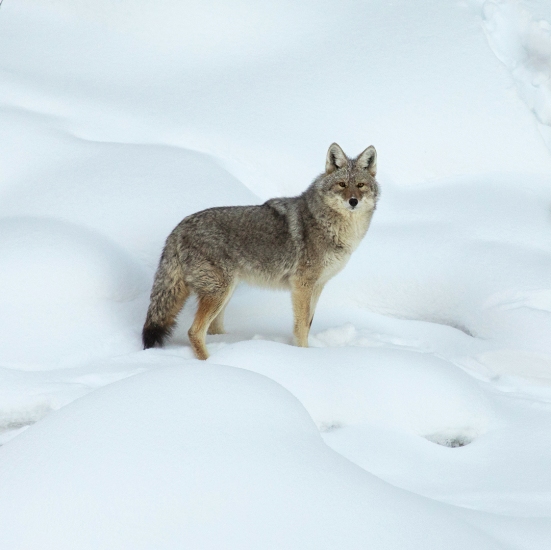
Seeing Yellowstone’s wolves up close remained at the top of my wildlife wish list, but I never seemed to be in the right place at the right time. The nearest I managed to get in January was to the Lamar Canyon pack, just three wolves, all of them black. One morning they sat down to rest on a hillside about 200 yards away.



While photographing the Lamar Canyon pack I met Cathy, a wolf watcher from Idaho who visits the park frequently with her husband. “How long have you been doing this?” I asked her.
“We started coming here in 1995,” Cathy said, which meant they jumped in at the very start, when wolves were initially reintroduced to the park. “First we came once a year for a week, then twice a year, then four times a year… I guess we’re hooked.”
“What keeps you coming back?”
“I’m not really sure. Pretty much everyone in Idaho hates wolves. I guess I’m just a sucker for the underdog.”
During almost every park visit I saw Doug, the longtime wolf watcher I butted heads with in December, and he couldn’t have been friendlier. At one point I asked Doug if I could say hello to his dog Jackson, a fluffy, well-behaved German Shepherd peering out happily from the back of a SUV. “Of course, please do,” Doug said. “He would be offended if you didn’t.”
Doug then let me look through his spotting scope, which he’d trained on some mountain goats grazing on a distant mountainside. It was the first time I’d ever seen mountain goats in Yellowstone. Doug seemed haughty and overbearing when we first met, but maybe I misjudged him. He – like most of the wolf watchers – is usually very willing to share knowledge and sightings with other visitors.
Often I also ran into Deby, the photographer I met the same morning I met Doug. I was glad to have a chance to tell Deby how much I enjoy her wildlife photos on Facebook, which are so good I’m both inspired and daunted. Deby’s contentious relationship with a handful of wolf watchers seems to dishearten her at times, and I hoped to counterbalance some of that by making sure she understands what a great example she’s been for me and – I’m sure – many other photographers trying to capture wildlife in the park.

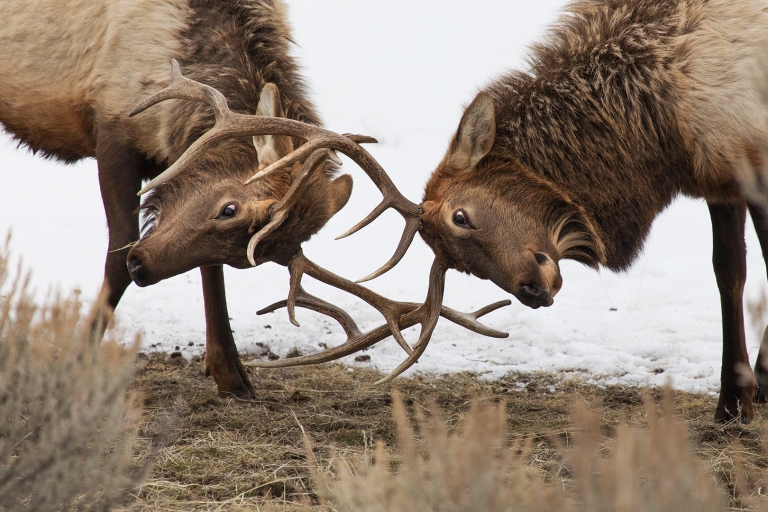
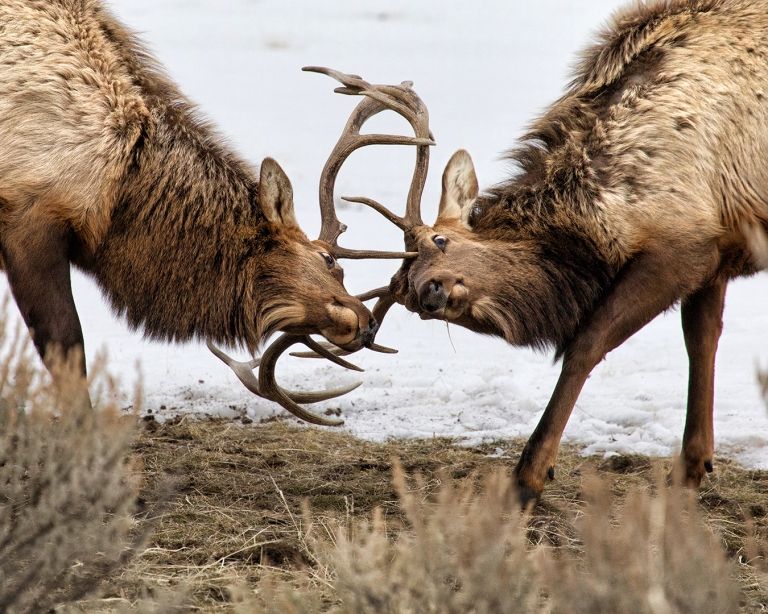


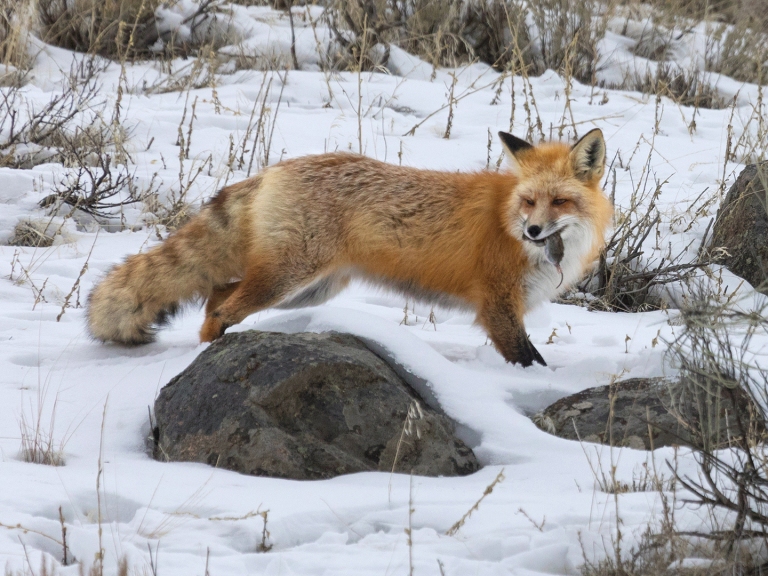

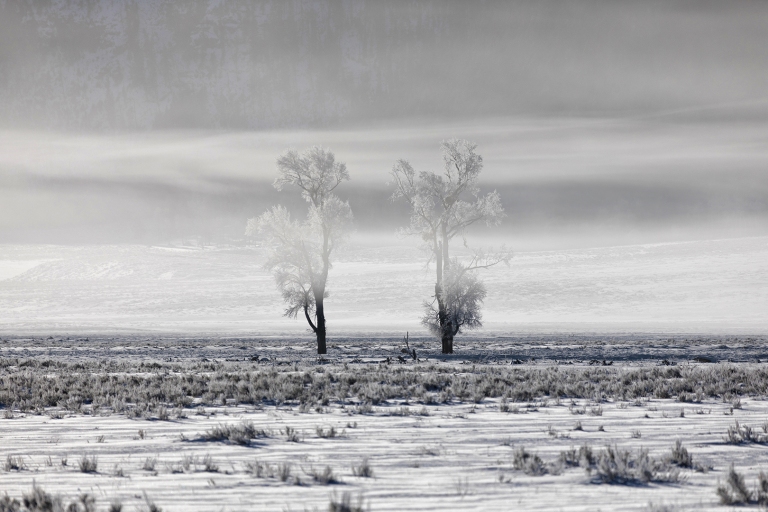

One afternoon I tried snowshoeing for the first time – nothing too intense, just a short hike along a ridge overlooking the Yellowstone River. After some initial struggles with the straps I managed to settle in and enjoy myself. It felt great to be able to cruise over deep snow. Not far into the hike I noticed a female bighorn sheep laying down just 10 feet from the trail, and she seemed not in the least alarmed by my presence.

Towards the middle of the month I spent two nights at the Old Faithful Snow Lodge, the only hotel in Yellowstone’s interior open in winter. Getting to the lodge was half the fun. Our snowcoach – basically a short yellow school bus jacked up on huge tires – left the Mammoth Hot Springs hotel early in the morning and spent more than four hours slowly navigating the snow-covered road to Old Faithful. Along the way we stopped to check out Gibbon Falls and one of the geyser basins.


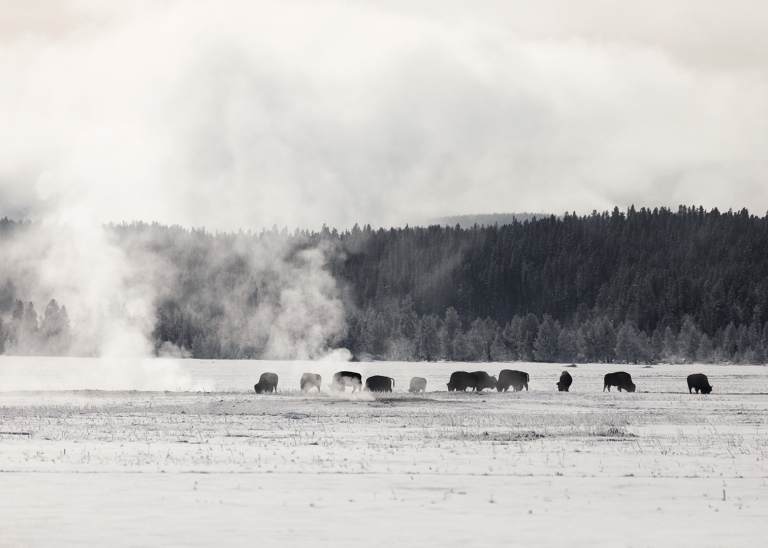
When we arrived at Old Faithful I had to cool my heels for a few hours before I could check into my room, a little cabin a short walk from the lodge. “Be sure to keep your sink running at all times so the pipes don’t freeze,” said the woman at the front desk. Not really what someone who has a tough time ignoring noises wants to hear.
There was just enough daylight left for a hike to the Morning Glory thermal pool.



After breakfast the next morning I set out on my longest snowshoeing expedition yet, a nine mile roundtrip to Lonestar Geyser. I didn’t spot any wildlife, but it was fun to see that area of the park covered in deep snow, and – aside from passing some cross-country skiers – I had the trail all to myself.



I woke the next morning to almost a foot of new snow. Not particularly interested in more snowshoeing and feeling restless, I tried to catch an early snowcoach back to Mammoth. But all the morning rides were booked and I couldn’t leave until the afternoon. On the return trip we stopped at Lower Geyser Basin and Firehole Falls, both beautiful under the fresh snow.

I was glad to have seen the Old Faithful area in winter, but a couple nights at the Snow Lodge was enough. I was excited to get back to Lamar Valley. For the next week I drove into the park every day.





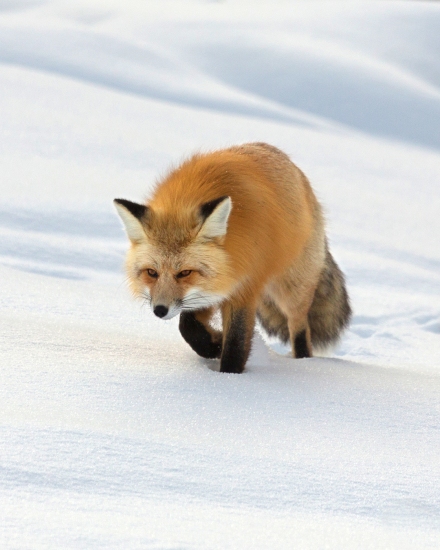




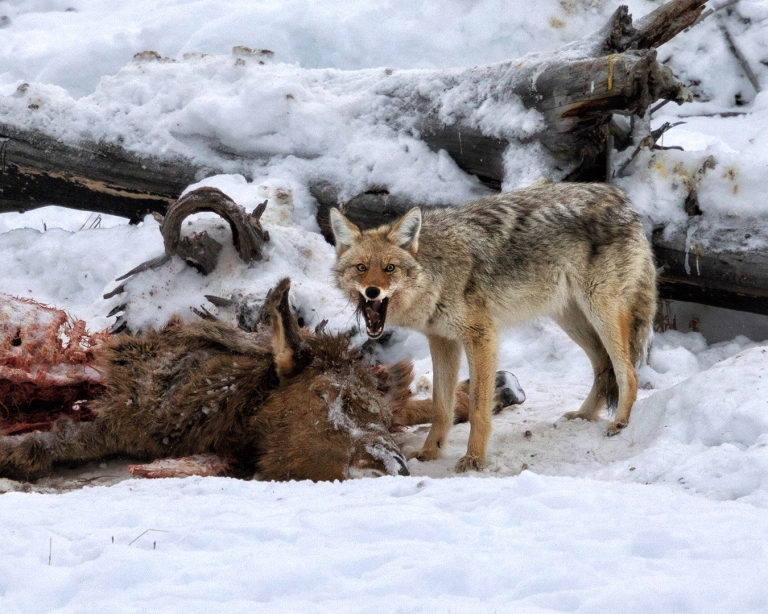
My niece Kate, a student at Montana State University in nearby Bozeman, joined me for a park trip one morning. The extremely cold weather – down to -22F in places – didn’t put a chill on our luck with wildlife. We spotted lots of animals, including the Lamar Canyon wolf pack. One of the wolf watchers was nice enough to let us look through her spotting scope, which brought the wolves so close we could see the expressions on their faces. It was great to catch up with my niece, and it helped a lot to have another set of eyes – Kate was responsible for our best sightings.

Overall I felt like I made progress in January. I found some of the wildlife that eluded me in December, thanks mostly to luck but also to learning more about the animals and their habits. I put snow tires on my car, making it easier to get around in bad weather. And I finally broke down and bought a new telephoto lens I’d been coveting for years, significantly improving my ability to capture wildlife from long distances.
In and around the park I’ve now seen bison, elk, deer, bighorn sheep, coyotes, pronghorn antelope, eagles, marmots, red foxes, mountain goats, moose, otters, black bears, grizzly bears, and wolves. But there’s almost as much I haven’t seen. Still on my wish list: wolves up close, mountain lions, badgers, lynx, bobcats, wolverines, beavers, owls, ospreys, weasels, and martens.
While visiting Yellowstone I’m occasionally struck by a feeling of ridiculous good fortune. I half expect someone to suddenly show up and inform me that it’s all been a mistake, that people aren’t just allowed to spend as much time as they’d like in such an incredible place, doing exactly what they want. But so far I seem to be getting away with it…

At the end of the month I drove back to Mountain View to visit Marie, covering all 1,100 miles in one marathon day. It was awesome to hang out with Marie and take a break from ice and snow. My visit happened to coincide with the once-in-150-years super blue blood moon, which I caught hovering over Coit Tower in downtown San Francisco.


What a wonderful post!
LikeLike
Amazing images. You saw it all.
LikeLike
Wow!! Amazing photos!!!!!
LikeLike
wonderful post!
LikeLike
Absolutely amazing photos. The one of the two trees drew me in but once viewing the rest, impossible to pick a favorite.
LikeLike